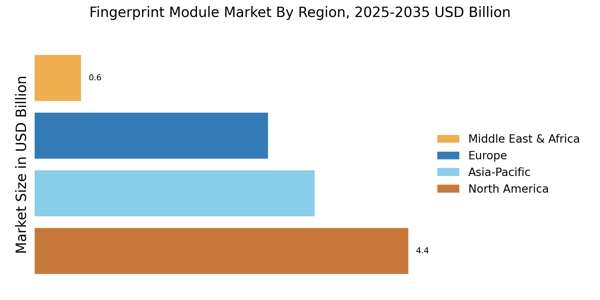Advancements in Technology
Technological advancements are significantly shaping the Fingerprint Module Market. Innovations in sensor technology, algorithms, and data processing capabilities are enhancing the accuracy and speed of fingerprint recognition systems. Recent developments, such as capacitive and optical sensors, are providing more reliable and efficient solutions for various applications. The market is also seeing the emergence of advanced features like liveness detection, which helps prevent spoofing attempts. As a result, the overall user experience is improving, leading to increased adoption across multiple sectors. The Fingerprint Module Market is expected to grow as these technological advancements continue to evolve, making fingerprint solutions more appealing to consumers and businesses alike.
Integration with IoT Devices
The Fingerprint Module Market is witnessing a significant trend towards the integration of fingerprint technology with Internet of Things (IoT) devices. As smart home technologies and connected devices proliferate, the demand for secure access control mechanisms is becoming increasingly critical. Fingerprint modules are being embedded in various IoT applications, such as smart locks and security systems, to provide seamless and secure user experiences. This integration not only enhances security but also simplifies user interactions with technology. Market analysis indicates that the IoT security market is expected to reach USD 50 billion by 2026, highlighting the potential for fingerprint modules to play a pivotal role in this expanding sector. The Fingerprint Module Market is thus likely to benefit from this convergence of technologies.
Growing Adoption in Mobile Devices
The Fingerprint Module Market is significantly influenced by the growing adoption of fingerprint technology in mobile devices. With smartphones becoming ubiquitous, manufacturers are increasingly incorporating fingerprint sensors to enhance device security and user convenience. Recent statistics indicate that over 70% of smartphones launched in 2025 feature integrated fingerprint modules, reflecting a strong consumer preference for biometric authentication. This trend is not limited to high-end devices; mid-range smartphones are also adopting fingerprint technology, broadening the market reach. As mobile payment systems gain traction, the need for secure authentication methods is further propelling the demand for fingerprint modules. The Fingerprint Module Market is thus likely to see continued growth as mobile device manufacturers prioritize security features.
Regulatory Compliance and Standards
The Fingerprint Module Market is also driven by the increasing emphasis on regulatory compliance and standards in various sectors. Governments and organizations are implementing stricter regulations regarding data protection and user privacy, necessitating the adoption of secure authentication methods. Fingerprint modules are becoming a preferred choice for compliance with these regulations, as they provide a reliable means of verifying identity. Industries such as finance and healthcare are particularly affected, as they handle sensitive information that requires robust security measures. The market is expected to expand as companies seek to align with these regulatory frameworks, ensuring that their security systems meet the necessary standards. This trend underscores the importance of fingerprint technology in the evolving landscape of data security.
Rising Demand for Biometric Security
The Fingerprint Module Market is experiencing a notable surge in demand for biometric security solutions. As security concerns escalate across various sectors, including banking, healthcare, and personal devices, organizations are increasingly adopting fingerprint modules to enhance security protocols. According to recent data, the biometric market is projected to grow at a compound annual growth rate of approximately 14% over the next five years. This growth is driven by the need for secure authentication methods that are both user-friendly and efficient. The integration of fingerprint modules into smartphones and laptops further underscores this trend, as consumers seek devices that offer robust security features. Consequently, the Fingerprint Module Market is poised for substantial growth as businesses and individuals prioritize safety and privacy.

















Leave a Comment